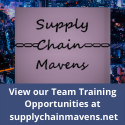
416: Mastering Data and Inventory with Porter Logic
416: Mastering Data and Inventory with Porter Logic

On this episode of The New Warehouse, Anya Skomorokhova, Co-Founder and Chief Operating Officer of Porter Logic joins the show to discuss the significance of data in today’s supply chain and warehousing industry. Be sure to tune in as Anya and Kevin delve into data management’s complexities and challenges, highlighting the increasing demand for comprehensive solutions to solve common problems in warehousing.
All Roads Lead Back to Inventory
After attending numerous trade shows focused on the supply chain industry over the past year, Anya found one clear lesson that resonated across discussions and pain points: all roads inevitably lead back to inventory. Whether the topic was manufacturing inefficiencies, order management intricacies, or demand planning, inventory stood out as the cornerstone upon which most challenges were built or solved.
Common Inventory Challenges
- Stockouts and Overstocking – Often, companies face challenges at the front end due to inadequate inventory visibility. This can result in stockouts or overstocking, which have financial implications and strain customer relationships.
- Delayed Shipments – Lack of real-time inventory data often leads to shipment delays. Companies spend countless hours manually tracking goods, causing a ripple effect throughout the supply chain.
- Lack of Flexibility – Traditional supply chain systems can be rigid, not allowing companies to efficiently adapt to real-time inventory changes. This lack of flexibility can become an Achilles’ heel, affecting responsiveness to market demands.
Understanding these issues firsthand, Porter Logic has tailored its technology stack to address them. While the core focus is inventory and warehousing, the platform’s capabilities extend naturally into order management and demand planning. Anya shares that Porter Logic allows customers to “Connect all their different systems together, fill the gaps between operations, and automate workflows across the supply chain.” This holistic approach ensures that you’re not just solving one problem but optimizing your entire supply chain.
Leveraging Data for Optimization and Resource Management
Anya believes data serves not just as a reflection of the current state but as a predictive tool, acting like a canary in a coal mine to signal upcoming challenges or opportunities.
The Role of Data – More than Numbers
- Leading Indicators – Accurate data and the proper set of KPIs can serve as leading indicators for future market trends, allowing businesses to proactively address potential issues or capitalize on emerging opportunities.
- Decision-making – While qualitative insights, such as gut feelings or stories, have their place, they lack the empirical evidence that data provides. Only data can validate these intuitions, helping businesses discern between actionable trends and mere noise.
Data Quality – Garbage In, Garbage Out
The quality of your data will directly impact the quality of your decisions.
- Timeliness – Data loses value when it isn’t real-time or near-real-time. In an environment where market dynamics shift rapidly, data that is even two weeks old could be irrelevant.
- Standardization – One of the biggest challenges in data management is the lack of standardized definitions. This absence often leads to mistrust among team members who may be using different data sources or definitions to calculate the same metrics.
Clean data and standard definitions yield most of the benefits. Anya believes, “You can get 80, 90% of the benefit just from having good clean data sources and having good, clean standard definitions, and enabling anybody in that organization to access that data or access that, that report or that metric at any time.” Before jumping onto the AI bandwagon, businesses should focus on streamlining their data pipelines and ensuring everyone has access to a ‘single source of truth.’
Making the Most of Data
Adopting a tactical approach allows businesses to hone in on specific data elements contributing to these KPIs, mitigating the chaos of conflicting data sources. These KPIs can evolve, providing the organization with a dynamic roadmap for operational improvements.
Balancing Metrics and Actions
While focusing on specific KPIs, it’s crucial to be mindful of the interconnectedness of metrics. Overemphasis on one metric can inadvertently deteriorate another. Organizations should strive for a balanced portfolio of KPIs that can guide them through operational bottlenecks, avoiding the paralysis of analysis that comes with conflicting data sources.
Technology as the Orchestrator
Consolidating and streamlining data from various systems can be made easier with technological solutions, especially when companies are struggling with legacy systems and technical debt. Whether you’re a smaller operation using spreadsheets or a large enterprise with multiple data warehouses, choose technology that can grow and adapt with you. Solutions that offer robust connectivity are increasingly vital in today’s interconnected business landscape.
Anya shares the example of a sizeable direct-to-consumer food business using varied third-party logistics (3PL) providers. Inefficient data management led them to mark bestselling products as “out of stock,” even when stock was available but not adequately accounted for. By automating the collection and standardization of data from multiple sources, the company achieved $131,000 in direct cost savings and a $250,000 revenue uplift in just a few months.
Key Takeaways
- Achieving 80-90% of supply chain benefits hinges on maintaining good, clean data and standardized definitions accessible across the organization in real time.
- Modern businesses require software that talks to each other, maximizes competitive advantages, and fills operational gaps.
- Businesses are investing in systems that offer robust connectivity and API integrations, as these features enable them to quickly adapt to unique operational needs and foster greater efficiency and profitability.
Listen to the episode below and leave your thoughts in the comments.
Guest Information
For more information on Porter Logic, click here.
To connect with Anya on LinkedIn, click here.





Fulfillment Optimization: Syncontext's Data-Driven Strategy
[…] 416: Mastering Data and Inventory with Porter Logic […]
Warehouse Labor Management: Innovations with Takt
[…] 416: Mastering Data and Inventory with Porter Logic […]
485: Addressing Excess Inventory With B-Stock Solutions » The New Warehouse
[…] 416: Mastering Data and Inventory with Porter Logic […]